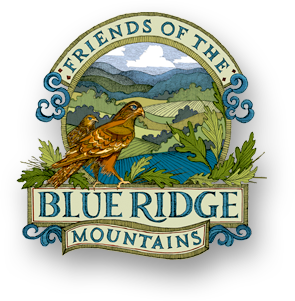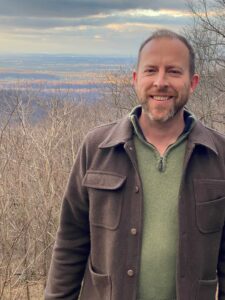Ashton Cole, Executive Director – Land Trust of Virginia
People You Should Know
This is one in a series of occasional articles highlighting the people whose decisions, activities and work directly impact the ways in which we enjoy, use, celebrate and protect our wonderful Blue Ridge Mountains.
Ashton Cole joined the Land Trust of Virginia (LTV) part-time in January 2007 with the responsibility of maintaining and stewarding the organization’s conservation easements. In January 2023, he was appointed Executive Director of the organization.
Ashton spent his childhood alternating between his mother’s home in Old town Winchester and his father’s home in Clarke County on the western slopes of the Blue Ridge near Bears Den. He also spent considerable time on his father’s small cattle farm just west of the Shenandoah River. His father passed unexpectedly in 1998, and the farm was sold shortly thereafter. There is some irony in the fact that, unknown to young Ashton, his father, who was Clarke County Commonwealth’s Attorney, had been convinced by his friend Bob Lee to put the farm into a conservation easement months before his death. This was 10 years before Ashton knew what a conservation easement was, let alone his future role in creating them and maintaining them across the state.
Ashton has a bachelor’s degree in International Relations from the University of Mary Washington. In pursuit of his degree, he spent two semesters studying in France, which gave him the opportunity to travel extensively and gain exposure to a wide array of different cultural traditions and ways of living in both urban and rural settings. After college, he experienced a slow but steady pull toward home, under the influence of his love for family, friends and his connection to life on the mountain. He has lived full-time at his father’s home since 2004. Originally built by his grandfather as a “get away” cabin in the 1930’s, the house has expanded over the years, and Ashton now lives there with his wife and their three children.
Ashton’s career in conservation started somewhat unexpectedly, with an opportunity to help acquire mapping and photography related to conservation easement donations. His father’s oldest friend Chris Dematatis served on the Board at LTV, and enlisted Ashton in 2005 to help part-time with his efforts to organize and improve LTV’s easement files.
LTV had been founded in 1992, and by the mid-2000’s, the organization had already acquired around 75 conservation easements. As expressed in its mission statement, LTV’s work in conserving land is focused on “partnering with private landowners to voluntarily protect and preserve working farmland or natural lands with significant scenic, historic, and / or ecological value using conservation easements”.
Conservation easements are legally binding agreements that landowners voluntarily enter into with a land trust or a government agency. Easements place limits on various uses, including the right of the landowner to subdivide or otherwise develop the land. The landowner who grants a conservation easement continues to own, use, and control their land, and they can sell it or pass it on to heirs. Conservations easements also include provisions for the landowner to build homes, farm buildings and other structures typically found on rural land.
LTV, as the easement holder, has a responsibility to steward each easement and monitor future uses of the land to ensure compliance with the terms of the easement and to enforce those terms if a violation occurs.
Although a conservation easement prohibits certain uses by the landowner, the easement does not make the land public. Neither the public nor the easement holder (e.g., LTV) have any right to use the land unless that’s specifically provided for under the terms of the agreement.
Landowners donating a conservation easement to LTV, or any other qualifying land protection organization, are eligible for tax benefits, the most notable of which are federal income tax deductions and state tax credits. These benefits depend on the value of the donation, which is determined by a qualified appraiser. The appraiser’s analysis focuses on the subject property’s fair market value before and after the easement donation, with the delta being the “easement value”, which is the value of the charitable donation for tax purposes.
LTV is the largest non-profit land trust in Virginia and is highly regarded within the conservation community for its conservation accomplishments and the stewardship of their easements. LTV currently holds 270 conservation easements protecting 35,240 acres in 35 counties across the Commonwealth.
Starting in 2013, LTV began a particular focus on the Blue Ridge Mountains with the Blue Ridge Conservation Initiative (also referred to as the “Blue Ridge Study”), which was a mapping and analysis project that focused on the 40-mile stretch of the Blue Ridge from Shenandoah National Park to the Potomac River at Harpers Ferry. In total, the study area was comprised of more than 200,000 acres in Loudoun, Fauquier, Warren, and Clarke Counties. Of the 200,000 acres, only about 30,000 (15%) were protected by state or national parks and conservation easements. This represented the largest expanse of unprotected land flanking the Blue Ridge Mountains in its entire 600-mile length.
With support from a grant from the Virginia Environmental Endowment in 2014, LTV worked with expert cartographer Paul Mitchell to map the area. In addition to the baseline map identifying the study area, LTV produced 21 maps showing occurrences of various natural resources and “conservation values” as they existed on the parcels within the study area. Examples include areas rich in amphibians, birds, reptiles and mammals, historic and archaeological resources, streams, wetlands and floodplains, prime farmland soils, development vulnerability, Appalachian Trail viewshed, and many others.
After mapping each variable independently, composite maps were created to show all 21 variables and the conservation priority rank of individual parcels within the study area. This led to the identification of 286 unprotected parcels, totaling over 41,000 acres, which were determined to be the highest priority parcels for future protection in this portion of the Blue Ridge Mountains.
With the data and maps in hand, LTV began the second phase of the project—the presentation of the information to the public. The information found in the study has been presented to dozens of conservation organizations, as well as in outreach meetings with the public, attended by interested landowners within the study area.
In early 2018, LTV received a second grant from Virginia Environmental Endowment to advance the Blue Ridge Study with additional staff support to direct the project and to conduct outreach to owners of those high-priority unprotected parcels. Friends partnered with LTV in 2023 to co-sponsor a series of seminars for landowners on the Blue Ridge with the goal of educating them about the process and the benefits of conservation easement donations.
In 2024, LTV received a generous contribution from Jacqueline Mars, with which it created the Mars Blue Ridge Conservation Fund (the “Mars Fund”). LTV describes the Mars Fund as being “used to encourage and assist in the donation of conservation easements to protect the Blue Ridge Mountains for the benefit of wildlife, hikers on the Appalachian Trail, and all who enjoy these unique mountains’ history and scenic beauty”.
The fund has enabled LTV to expand its efforts in protecting the Blue Ridge, supporting acquisition of six easements protecting 660 mountainside acres, with another three easements in the pipeline covering 775 acres. The Fund has also provided an opportunity for LTV staff to engage more actively in promotion of land conservation through the Blue Ridge Conservation Initiative. In 2025, LTV plans to update its BRCI mapping, and to increase its outreach efforts in the study area.
In addition to the Mars Fund, LTV administers two other funds that have played a significant role in protecting the land surrounding, if not located directly on, the Blue Ridge Mountains. These include the Malcolm Baldwin Farmers Fund and the Deborah Whittier Fitts Battlefield Stewardship Fund, described below.
In his nearly twenty years at LTV, Ashton has seen the organization become increasingly effective, sophisticated and professional, and neither he nor the Land Trust of Virginia show any signs of slowing down. Despite successes, the need and opportunities for voluntary land conservation are ongoing, and the work is truly never done. For Ashton, it’s a labor of love mixed with a bit of enlightened self-interest, given that he’s raising his family in the type of rural setting that he has dedicated his career to conserving. The Blue Ridge Mountains in particular need protection and stewardship, and Ashton’s goal is to make as much of a difference as he can, and to pass that ethic along to the next generation.
In addition to the Mars Blue Ridge Conservation Fund, LTV maintains the following funds:
Deborah Whittier Fitts Battlefield Stewardship Fund — Established in 2009, the fund was created in memory of the late Deborah Whittier Fitts, a long-time professional journalist who reported for both the Loudoun Times Mirror and the Civil War News. The fund has been pivotal in safeguarding and preserving Virginia’s Civil War history. It is used to help reduce the easement donation costs that landowners face, which can sometimes be a disincentive to pursuing the conservation option.
Malcom Baldwin Farmers Fund — Established in 2019, the fund is named for Malcolm Forbes Baldwin, Land Trust of Virginia’s former board member and friend, in honor of Malcolm’s lifetime of service to conservation and his support for family farms in his community. The fund is utilized to help underwrite the fees for conservation easement donations on properties that have historically been in agricultural use.


Leave a Reply
Your email is safe with us.